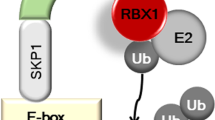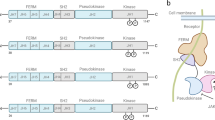Abstract
The signalling pathway that comprises JAK kinases and STAT proteins (for signal transducer and activator of transcription) is important for relaying signals from various cytokines outside the cell to the inside1,2,3. The feedback mechanism responsible for switching off the cytokine signal has not been elucidated. We now report the cloning and characterization of an inhibitor of STAT activation which we name SSI-1 (for STAT-induced STAT inhibitor-1). We found that SSI-1 messenger RNA was induced by the cytokines interleukins 4 and 6 (IL-4, IL-6), leukaemia-inhibitory factor (LIF), and granulocyte colony-stimulating factor (G-CSF). Stimulation by IL-6 or LIF of murine myeloid leukaemia cells (M1 cells) induced SSI-1 mRNA expression which was blocked by transfection of a dominant-negative mutant of Stat3, indicating that the SSI-1 gene is a target of Stat3 (refs 4, 5, 6, 7). Forced overexpression of SSI-1 complementary DNA interfered with IL-6- and LIF-mediated apoptosis and macrophage differentiation of M1 cells, as well as IL-6 induced tyrosine-phosphorylation of a receptor glycoprotein component, gp130, and of Stat3. When SSI-1 is overexpressed in COS7 cells, it can associate with the kinases Jak2 and Tyk2. These findings indicate that SSI-1 is responsible for negative-feedback regulation of the JAK–STAT pathway induced by cytokine stimulation.
This is a preview of subscription content, access via your institution
Access options
Subscribe to this journal
Receive 51 print issues and online access
$199.00 per year
only $3.90 per issue
Buy this article
- Purchase on SpringerLink
- Instant access to full article PDF
Prices may be subject to local taxes which are calculated during checkout




Similar content being viewed by others
References
Darnell, J. E. J, Kerr, I. M. & Stark, G. R. Jak–STAT pathways and transcriptional activation in response to IFNs and other extracellular signaling proteins. Science 264, 1415–1421 (1994).
Ihle, J. N. Cytokine receptor signalling. Nature 377, 591–594 (1995).
Kishimoto, T., Akira, S., Narazaki, M. & Taga, T. Interleukin-6 family of cytokines and gp130. Blood 86, 1243–1254 (1995).
Akira, S. et al. Molecular cloning of APRF, a novel IFN-stimulated gene factor 3 p91-related transcription factor involved in the gp130-mediated signaling pathway. Cell 77, 63–71 (1994).
Zhong, Z., Wen, Z. & Darnell, J. E. J Stat3: a STAT family member activated by tyrosine phosphorylation in response to epidermal growth factor and interleukin-6. Science 264, 95–98 (1994).
Minami, M. et al. STAT3 activation is a critical step in gp130-mediated terminal differentiation and growth arrest of a myeloid cell line. Proc. Natl Acad. Sci. USA 93, 3963–3966 (1996).
Nakajima, K. et al. Acentral role for Stat3 in IL-6-induced regulation of growth and differentiation in M1 leukemia cells. EMBO J. 15, 3651–3658 (1996).
Taga, T. & Kishimoto, T. Cytokine receptors and signal transduction. FASEB J. 6, 3387–3396 (1992).
Ip, N. Y. et al. CNTF and LIF act on neuronal cells via shared signaling pathways that involve the IL-6 signal transducing receptor component gp130. Cell 69, 1121–1132 (1992).
Kondo, M. et al. Functional participation of the IL-2 receptor γ chain in IL-7 receptor complexes. Science 262, 1453–1454 (1994).
Sakamaki, K., Miyajima, I., Kitamura, T. & Miyajima, A. Critical cytoplasmic domaisn of the common β subunit of the human GM-CSF, IL-3 and IL-5 receptors for growth signal transduction and tyrosine phosphorylation. EMBO J. 11, 3541–3549 (1992).
Heldin, C. H. Dimerization of cell surface receptors in signal transduction. Cell 80, 213–223 (1995).
Adachi, M. et al. Mammalian SH2-containing protein tyrosine phosphatases. Cell 85, 15 (1996).
Yi, T., Mui, A. L.-F., Krystal, G. & Ihle, J. N. Hematopoietic cell phosphatase associates with the interleukin-3 (IL-3) receptor β chain and down-regulates IL-3-induced tyrosine phosphorylation and mitogenesis. Mol. Cell. Biol. 13, 7577–7586 (1993).
Klingmüller, U., Lorenz, U., Cantley, L. C., Neel, B. G. & Lodish, H. Specific recruitment of SH-PTP1 to the erythropoietin receptor causes inactivation of JAK2 and termination of proliferative signals. Cell 80, 729–738 (1995).
Yoshimura, A. et al. Anovel cytokine-inducible gene CIS encodes an SH2-containing protein that binds to tyrosine-phosphorylated interleukin 3 and erythropoietin receptors. EMBO J. 14, 2816–2826 (1995).
Mui, A. L., Wakao, H., Kinoshita, T., Kitamura, T. & Miyajima, A. Suppression of interleukin-3-induced gene expression by a C-terminal truncated Stat5: role of Stat5 in proliferation. EMBO J. 15, 2425–2433 (1996).
Heim, M. H., Kerr, I. M. Star G. R. & Darnell, J. E. J Contribution of STAT SH2 groups to specific interferon signaling by the Jak–STAT pathway. Science 267, 1347–1349 (1995).
Hou, J. et al. An interleukin-4-induced transcription factor: IL-4 Stat. Science 265, 1701–1706 (1994).
Hu-Li, J., Ohara, J., Watson, C., Tsang, W. & Paul, W. E. Derivation of a T cell line that is highly responsive to IL-4 and IL-2 (CT.4R) and of an IL-2 hyporesponsive mutant of that line (CT.4S). J. Immunol. 142, 800–807 (1989).
Tian, S. S., Lamb, P., Seidel, H. M., Stein, R. B. & Rosen, J. Rapid activation of the STAT3 transcription factor by granulocyte colony-stimulating factor. Blood 84, 1760–1764 (1994).
Wakao, H., Harada, N., Kitamura, T., Mui, A. L.-F. & Miyajima, A. Interleukin 2 and erythropoietin activate STAT5/MGF via distinct pathways. EMBO J. 14, 2527–2535 (1995).
Narazaki, M. et al. Activation of JAK2 kinase mediated by the interleukin 6 signal transducer gp130. Proc. Natl Acad. Sci. USA 91, 2285–2289 (1994).
Stahl, N. et al. Association and activation of Jak-Tyk kinases by CNTF-LIF-OSM-IL-6Rβ receptor components. Science 263, 92–95 (1994).
Stahl, N. et al. Choice of STATs and other substrates specified by modular tyrosine-based motifs in cytokine receptors. Science 267, 1349–1353 (1995).
Starr, R. et al. Afamily of cytokine-inducible inhibitors of signalling. Nature 387, 917–921 (1997).
Endo, T. A. et al. Anew protein containing an SH2 domain that inhibits JAK kinases. Nature 387, 921–924 (1987).
Acknowledgements
We thank T. Tanaka for IL-4 and CT4S cells; S. Nagata for pEF-BOS vector and Jak2 cDNA; J. Krolewski for Tyk2 cDNA; K. Yasukawa for recombinant IL-6 and sIL-6R; Y. Shima, H. Danno, K. Kunisada and H. Tagoh for technical assistance; H. Saito for discussion; and A. Nobuhara for secretarial assistance. This work was supported by a Grant-in-Aid from the Ministry of Education, Science and Culture, Japan.
Author information
Authors and Affiliations
Author notes
The sequence of SSI-1 has been deposited with Genbank, under accession number AB000710.
Corresponding author
Rights and permissions
About this article
Cite this article
Naka, T., Narazaki, M., Hirata, M. et al. Structure and function of a new STAT-induced STAT inhibitor. Nature 387, 924–929 (1997). https://doi.org/10.1038/43219
Received:
Accepted:
Issue Date:
DOI: https://doi.org/10.1038/43219



